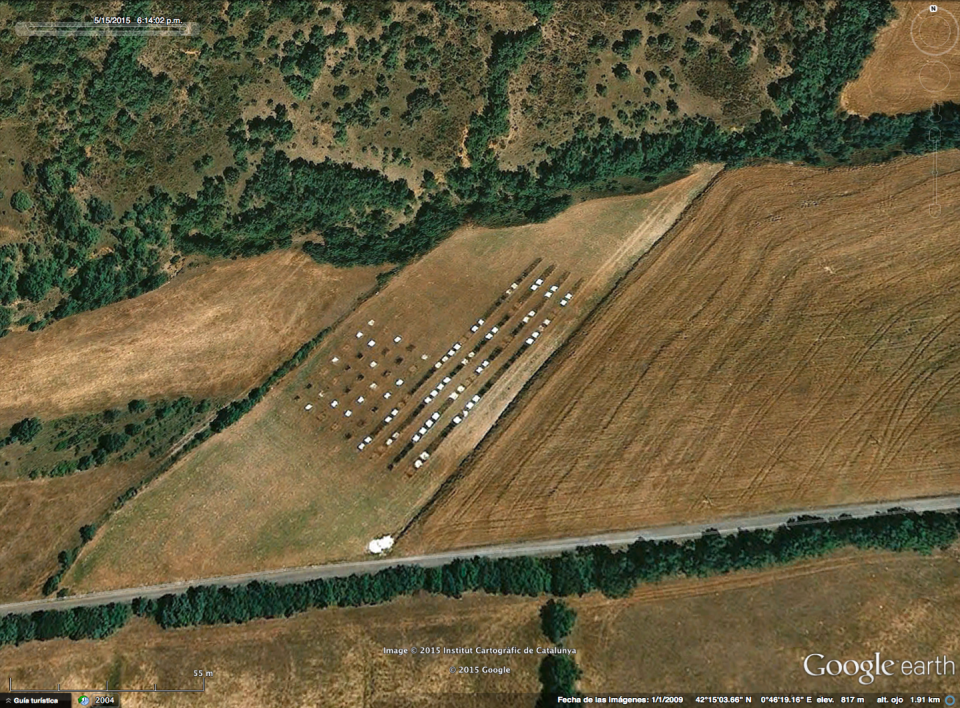
This study is aimed at accelerating the onset of truffle production by avoiding weed competition around the recently planted Tuber melanosporum inoculated seedlings. By doing so reducing the labor costs, avoiding compacting the soil or loosing the organic certification of the truffle orchard.
Seedlings inoculated with Tuber melanosporum face strong competition from weeds after being planted in the field. This reduces their growth and also delays truffle fruiting. Weed competition can be reduced by mechanical or chemical means. Mechanical means are problematic because heavy machinery compacts the soil which is undesirable for the growth of the fungus, and manual work is very time consuming and, therefore, expensive. Application of herbicides works well but blocks the access of the truffles to organic marketing circuits, common in gourmet food products.
We have studied how the mycelium of Tuber melanosporum grows out of the seedling’s plug and colonizes the surrounding soil under different methods to control weed competition.
We tested 7 strategies for reducing weed competition:
(1)Single layer white woven polypropylene fabrics of 110 g m−2,
(2) Double layer white woven polypropylene fabrics of 110 g m−2
(3)Single layer black woven polypropylene fabrics of 110 g m−2,
(4)Double layer black woven polypropylene fabrics of 110 g m−2
(5) white calcareous 3–6-cm-diameter stones,
(6) 8–10 cm deep, soil tilling and a
(7) manual weed control, plus an untreated control.
Double layer white fabric strongly favored the growth of T. melanosporum outside of the seedling plug and its capacity to colonize the surrounding soil.
Before establishing a truffle plantation, the field should be cultivated to remove all weeds. After planting the seedlings, they should be mulched with a double layer of white woven polypropylene plastic of 2x2 m to prevent the growth of weeds and the evaporation of water. This mulch should be removed after 4 to 5 years when the burns start to appear and the mycelium of T. melanosporum inhibits the growth of weeds around the seedlings.
Alternatively, a double layer of woven plastic mulch with a black bottom layer and a white top layer could be used.
Impacts:
A generalized use of mulches will reduce the need of labor to maintain the fields weed free, and will accelerate the onset of truffle production in the orchards, which will reduce the financial burden of the planting investment before the plantation starts to generate income. And all this maintaining the certification of organic food.
Weakness:
Removing the mulching materials is labor intensive.
Removing the mulching plastics is labor intensive. Therefore, the next challenge is to use plastics that are permeable to water so that rain and irrigation water can reach the soil, and also biodegradable so that the soil microbiota would digest them after they become no longer useful.
Many biodegradable polymers are being tested in agriculture and some have proven effective. The next step would be to test them in truffle cultivation to see if they pose any problem to the growth or fruiting of the fungus T. melanosporum.
Carlos Colinas, carlos.colinas@udl.cat
Christine Fischer, christine.fischer@ctfc.es
Daniel Oliach, daniel.oliach@ctfc.es
José Antonio Bonet, jantonio.bonet@udl.cat
Further information
Olivera A, Fischer CR, Bonet JA, Martínez de Aragón J, Oliach D, Colinas C (2011) Weed management and irrigation are key treatments in emerging black truffle (Tuber melanosporum) cultivation. New For. doi: 10.1007/s11056-011-9249-9
Fischer, CR., Oliach, D., Bonet, JA., and Colinas, C. (2017). Best Practices for Cultivation of Truffles. Forest Sciences Centre of Catalonia, Solsona, Spain; Yaşama Dair Vakıf, Antalaya, Turkey. 68pp. ISBN: 978-84-697-8163-0.
Olivera, A.; Bonet, J.A. Palacio, L., Colinas, C. (2014). Weed control modifies Tuber melanosporum extramatrical mycelial expansion in Young oak plantations. Annals of Forest Sciences, 71 (4): 495-504. DOI 10.1007/s13595-014-0360-x.
Institut Cartogràfic de Catalunya / Google

Mulching test. Source: Carlos Colinas
